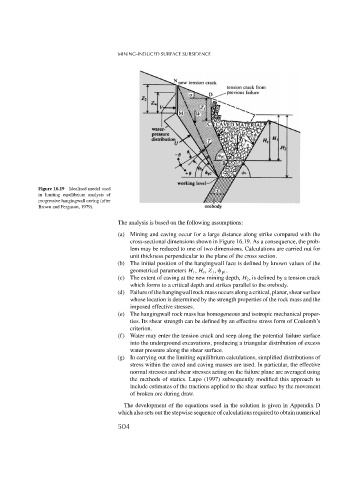Page 522 - Rock Mechanics For Underground Mining
P. 522
MINING-INDUCED SURFACE SUBSIDENCE
Figure 16.19 Idealised model used
in limiting equilibrium analysis of
progressive hangingwall caving (after
Brown and Ferguson, 1979).
The analysis is based on the following assumptions:
(a) Mining and caving occur for a large distance along strike compared with the
cross-sectional dimensions shown in Figure 16.19. As a consequence, the prob-
lem may be reduced to one of two dimensions. Calculations are carried out for
unit thickness perpendicular to the plane of the cross section.
(b) The initial position of the hangingwall face is defined by known values of the
geometrical parameters H 1 , H c , Z 1 , p1 .
(c) The extent of caving at the new mining depth, H 2 , is defined by a tension crack
which forms to a critical depth and strikes parallel to the orebody.
(d) Failure of the hangingwall rock mass occurs along a critical, planar, shear surface
whose location is determined by the strength properties of the rock mass and the
imposed effective stresses.
(e) The hangingwall rock mass has homogeneous and isotropic mechanical proper-
ties. Its shear strength can be defined by an effective stress form of Coulomb’s
criterion.
(f) Water may enter the tension crack and seep along the potential failure surface
into the underground excavations, producing a triangular distribution of excess
water pressure along the shear surface.
(g) In carrying out the limiting equilibrium calculations, simplified distributions of
stress within the caved and caving masses are used. In particular, the effective
normal stresses and shear stresses acting on the failure plane are averaged using
the methods of statics. Lupo (1997) subsequently modified this approach to
include estimates of the tractions applied to the shear surface by the movement
of broken ore during draw.
The development of the equations used in the solution is given in Appendix D
which also sets out the stepwise sequence of calculations required to obtain numerical
504

